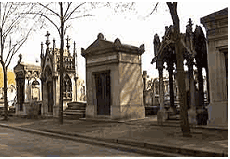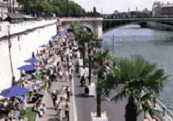Unusual spots
If you have enough time during your stay in Paris, once you have completed the tour of the capital, there are some curious spots to be visited and discovered. These places are distinctly unusual and may evoke wonder or even inspire fear. Take a look at this picturesque and original circuit…
THE CEMETERIES
- Cimetière du Montparnasse (14th)

Source : www.parisbalades.com
tel. 01 40 71 75 60
It occupies the fields of three ancient farms, which is the origin of the old windmill on the western corner of the tower. In the 17th century, this place became the private necropolis of the order of Saint-Jean-de-Dieu.
In the beginning of the 19th century, the Prefect of
Paris had the land purchased by the city to open one of three
new cemeteries outside the city walls. The first inhumation took
place in 1824.
The cemetery has been entirely consecrated to permanent
resting places since 1874, and within its walled are buried many
famous writers, artists and editors: Zadkine, Tristan Tzara, Baudelaire,
Soutine, Saint-Saens, Antoine Bourdelle, Beauvoir, Bartholdi,
Jean Seberg. Also to be found there are the tombs of Dreyfus and
Henri Poincaré. The tomb of Brancusi is not in the same
place as his cubist sculpture “The Kiss” which adorns
another tomb (at the junction of rue Richard and bd Edgar Quinet,
division 19)Cimetière du Père
Lachaise (metro Père Lachaise , 20th)
Main entrance on Boulevard de Ménilmontant, interactive
illustrated map available)
(tel. 01 43 70 70 33, open 07.30 -18.00 from 16 March to 5 November,
08.00 - 17.30 from 6 November to 15 March, Saturdays from 08.30,
Sundays from 09.00)

© Paris Tourist Office -
Photographe : Marc Verhille
Many famous tombs are scattered through the cemetery: Jim Morrison, the recumbent effigy of Victor Noir, Chopin, Allan Kardec, Héloïse and Abélard, etc. In the south west corner rises the Mur des Fédérés (Wall of the Federated). At the end of the bloody week of the Commune in May 1871, the insurgents entrenched in the cemetery gave battle to the Versaillais (the army established t Versailles). The survivors were shot against this wall. To the side, several monuments pay homage to the victims of the Nazis.
Cimetière de Montmartre (18è)
20 Avenue Rachel 75018 Paris (a brochure is available at the
entrance, tel. 01 43 87 64 24).
A pleasant, verdant cemetery where the architecture of terraces,
staircases and overhangs seems somewhat rickety. There can found
are the tombs of Berlioz, Dalida, Degas, Stendhal, Truffaut,
Zola and others…
THE CATACOMBS

© Paris Tourist Office -
Photographe : Henri Garat
THE SEWERS click here
The visit to the sewers moves through several galleries which were purpose-built to allow visitors to discover parts of the sewer network.
The visit is organised in the heart of the network, where one can see the collection drain beneath Avenue Bosquet, the main sewer line under Rue Cognacq-Jay, the storm drain beneath Place de la Résistance or indeed the beginning of the channel that brings some of the used water from the left bank to the treatment centre in Achères.
Also displayed throughout the corridors of the museum and along
the walls of the tour route are numerous models and real machines,
some of which were used in the past and some which are still
used today for the maintenance of the network.
Visitors also have the chance to visit a "wagon-vanne"
used for the dredging of the sewers – a sort of floating
sluice gate which is used to clean out the big collector tanks,
or indeed a very old pump used to control the water levels.
An audio visual display room completes the tour.
Metro : Pont de l'Alma, rive gauche,
Facing 93 quai d'Orsay.
75007 Paris
Tel. : 01 53 68 27 81
Closed Thursdays and Fridays
Saturday to Wednesday 11.00 – 16.00 from 1/10 to 30/04
Saturday to Wednesday 11.00 – 17.00 from 1/05 to 30/09
Museum closed for the last three weeks of January
PARIS PLAGE

© Paris Tourist Office -
Photographe : Catherine Balet
Make the most of your stay by visiting the museums and monuments. Not to mention around Paris, the boat trips, the bridges, the Parisian squares, the zoos and farms of Paris, the operas, or the parks and gardens where you can stroll around at your ease.
- Paris-city Partners :
- Music News
- Rock, Jazz & Blues CDs
- Learn French in Paris
- Learn French in France
- Paris Junior Programs
- Learn English in England
- Business English Courses
- Need a translation?
- For teachers of French
- French Exercise & Tests
- Directories
- English courses for Teens in UK
- Camps for Teens in England
- Language Courses Abroad
- English courses in England
- Learn a Language Abroad


